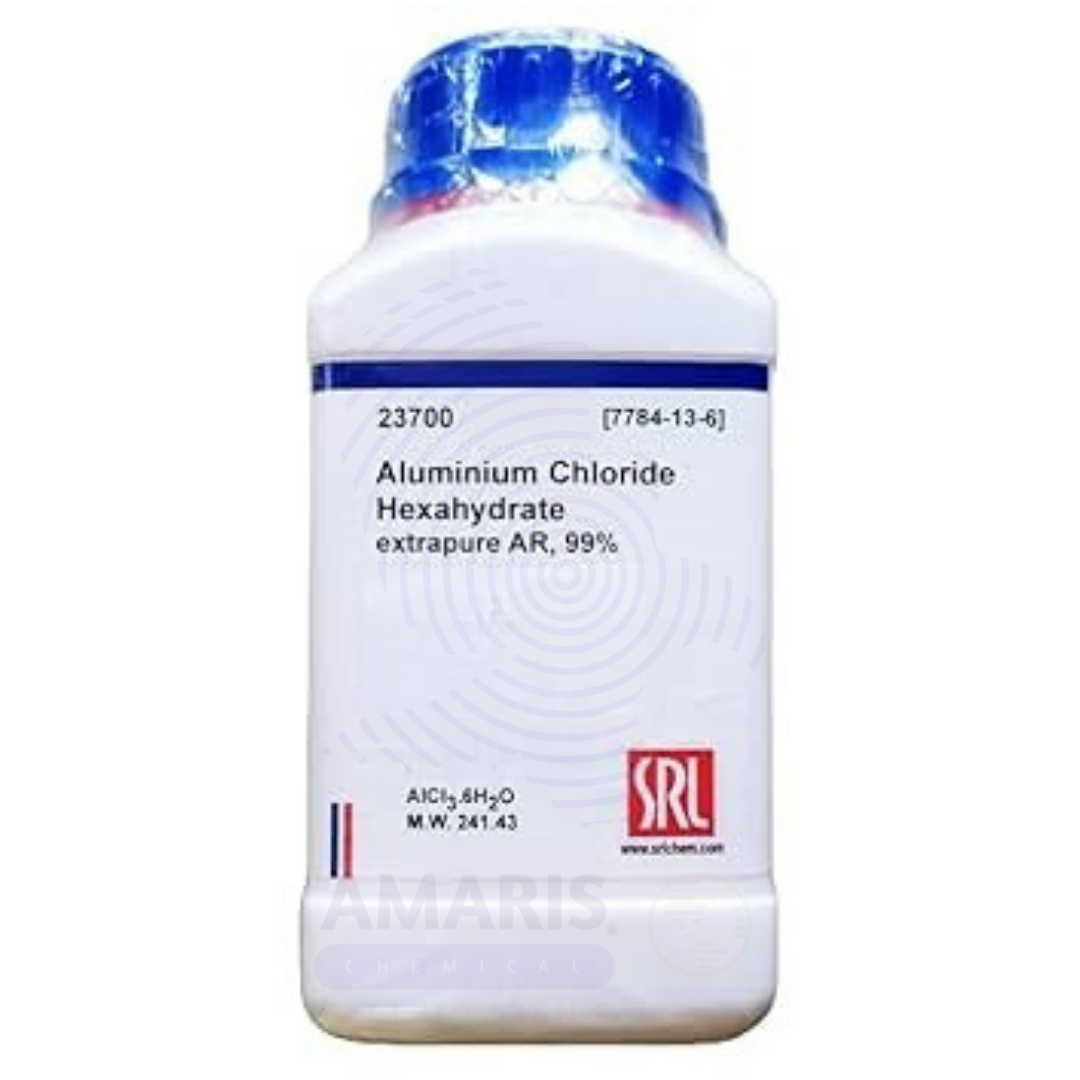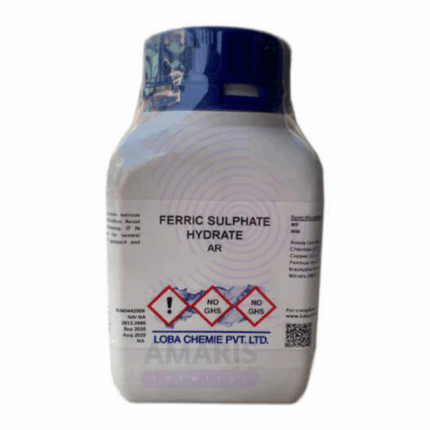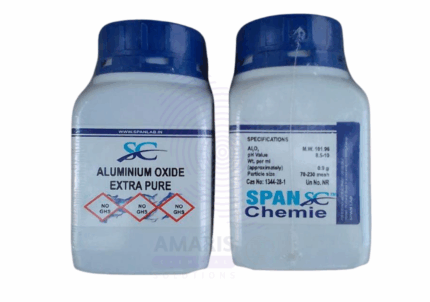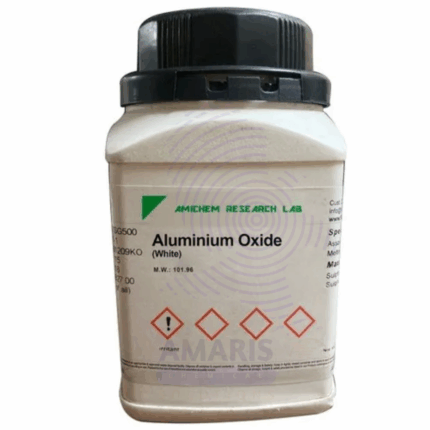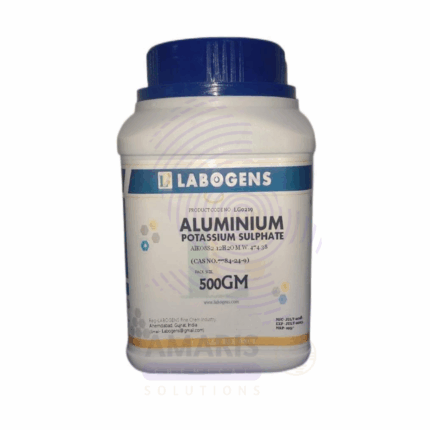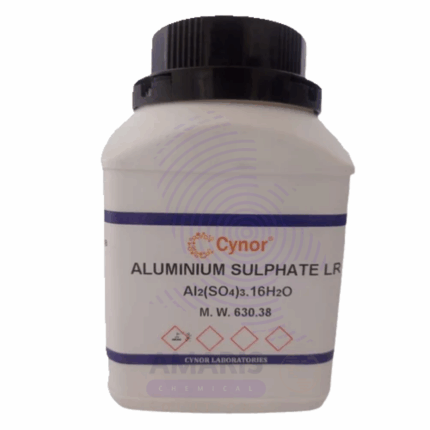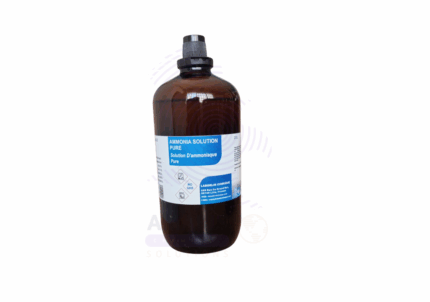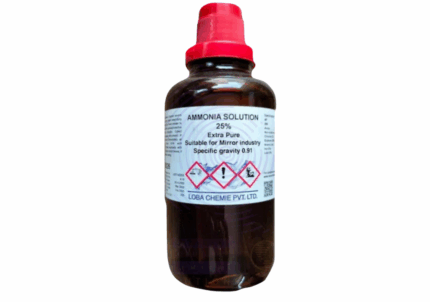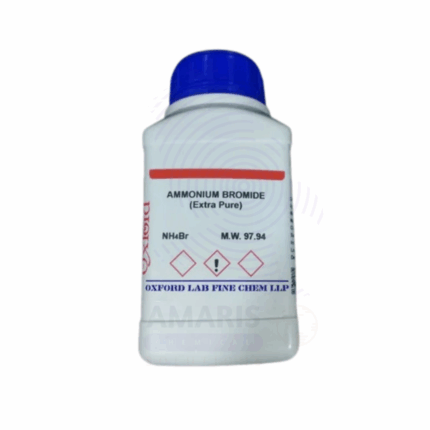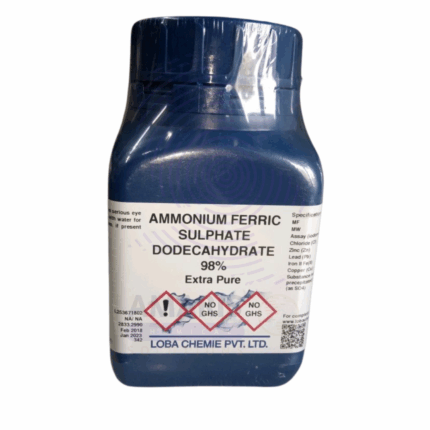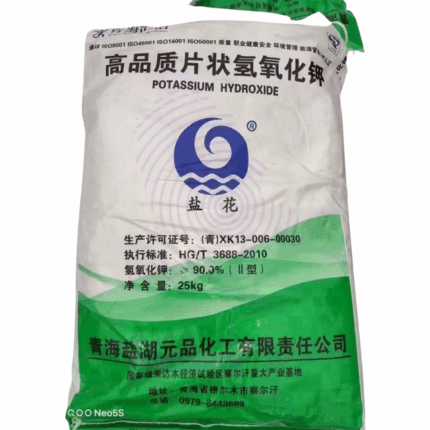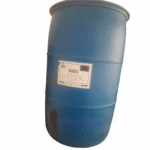
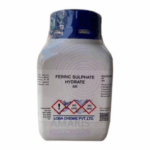
Aluminium Chloride Hydrated Extra Pure
$ 26.00 Original price was: $ 26.00.$ 25.67Current price is: $ 25.67.
Aluminium Chloride Hydrated Extra Pure is a high-purity, white to pale yellow crystalline compound containing bound water molecules, making it less reactive than its anhydrous counterpart but still highly effective in various laboratory applications. It is commonly used in aqueous-phase reactions, coordination chemistry, and as a reagent for studying aluminum ion behavior in solution. The hydrated form offers enhanced stability and ease of handling, making it suitable for educational experiments, buffer formulations, and inorganic synthesis where precise aluminum content is required. Its extra pure grade ensures minimal interference from impurities, supporting accurate and reproducible results in analytical and research settings. Proper storage in a cool, dry place is essential to prevent further hydration or contamination.
Aluminium Chloride Hydrated Extra Pure
Primary Uses
- Inorganic Chemistry Reagent
- Used in studying coordination complexes and reactions involving aluminum salts in aqueous media.
- Analytical Chemistry
- Serves as a standard reagent for aluminum ion reactions, including precipitation with hydroxides or oxalates.
- Educational Chemistry Experiments
- Demonstrates hydration, salt hydrolysis, and Lewis acid–base theory in aqueous environments.
- Reactant for Synthesizing Other Aluminium Compounds
- Acts as a starting material in the preparation of alum, aluminum hydroxide, or aluminum sulfate.
- Catalyst for Water-Compatible Organic Reactions
- Functions as a mild Lewis acid in hydrolysis-tolerant organic transformations or polymerization research.
Secondary Uses
- Hydrolysis and pH Studies
- Used to demonstrate salt hydrolysis and its effect on pH, particularly in teaching buffer systems.
- Electrochemical Research
- Investigated for its ionic conductivity and aluminum-ion migration in aqueous electrolysis studies.
- Simulation of Soil or Water Contamination
- Used in environmental chemistry experiments to model aluminum mobility in aquatic systems.
- Crystallization and Solubility Experiments
- Explored in lab studies on solubility curves, crystallization behavior, and hydrate formation.
- Corrosion Testing in Material Science Labs
- Studied for its effect on metals in simulated acidic or salt-rich environments.
| PACK SIZE |
500 grams Plastic Tin |
|---|
1. Basic Identification Attributes
- Chemical Name: Aluminium Chloride Hexahydrate (IUPAC: Aluminium trichloride hexahydrate)
- CAS Number: 7784-13-6
- HS Code: 28273000
- Molecular Formula: AlCl₃·6H₂O
- Synonyms:
- Aluminium trichloride hexahydrate
- Aluminum chloride hydrate
- Aluminium chloride solution (when dissolved in water)
- AlCl₃·6H₂O
2. Physical & Chemical Properties
- Physical State: Solid (crystalline, deliquescent)
- Color & Odor: White to pale yellow crystals; odorless or faintly acidic smell
- Boiling Point: Decomposes (no true boiling point)
- Melting Point: ~100°C (with loss of water)
- Density/Specific Gravity: ~1.78 g/cm³
- Solubility:
- Water: Very soluble; forms strongly acidic solution
- Organic Solvents: Slightly soluble in ethanol, methanol
- pH Level: Strongly acidic (~2–3 in 1% solution)
- Vapor Pressure & Volatility: Non-volatile
- Flash Point: Not flammable
- Autoignition Temperature: Not applicable
- Viscosity: Not applicable (solid)
3. Safety & Hazard Attributes
- Hazard Class (GHS):
- Skin Corrosion/Irritation (Category 1B)
- Serious Eye Damage (Category 1)
- NFPA Ratings:
- Health: 2
- Flammability: 0
- Reactivity: 1
- Exposure Limits:
- No specific OSHA or ACGIH limit; treat as acidic aluminium salt
- Reactivity:
- Reacts with bases, water (deliquescent), and oxidizing agents
- Slowly hydrolyzes in air releasing HCl vapor
4. Storage & Handling Attributes
- Storage Conditions:
- Store in tightly sealed container
- Cool, dry, and well-ventilated area
- Incompatible Materials:
- Strong bases, oxidizing agents, reactive metals
- Container Type:
- HDPE jars or corrosion-resistant bottles
- Shelf Life & Expiration Date:
- 1–2 years if kept sealed and dry
- Special Handling Requirements:
- Use gloves, safety goggles, and lab coat
- Avoid inhalation of dust and skin contact
- Use in fume hood when preparing solutions
5. Regulatory & Compliance Attributes
- Regulatory Status:
- Listed in TSCA, REACH
- Common reagent in academic and analytical laboratories
- Transportation Restrictions:
- Not classified as dangerous for transport in solid form
- UN number may apply when in solution
- Waste Disposal Method:
- Dilute and neutralize before disposal
- Dispose of in accordance with local hazardous waste regulations
6. Environmental & Health Impact
- Ecotoxicity:
- Harmful to aquatic life due to acidity and aluminium ion toxicity
- Persistence in Environment:
- Dissolves and hydrolyzes easily; does not persist
- Carcinogenicity/Mutagenicity:
- Not classified as carcinogenic or mutagenic
- Biodegradability:
- Inorganic salt; not biodegradable, but breaks down to environmentally manageable components
SAFETY PRECAUTIONS
- Personal Protective Equipment (PPE):
- Use chemical-resistant gloves (e.g., nitrile), lab coat, safety goggles, and optionally a face shield for bulk handling.
- Work in a well-ventilated lab or under a chemical fume hood.
- Handling:
- Avoid dust formation and prevent contact with skin, eyes, and clothing.
- Avoid inhalation of dust or fumes—may be irritating to mucous membranes.
- Do not mix with strong bases or oxidizing agents.
- Storage:
- Store in tightly closed, corrosion-resistant containers in a cool, dry, and well-ventilated area.
- Keep away from incompatible substances such as alkalis and strong oxidizers.
- Protect from moisture and humid conditions to maintain chemical stability.
- Hygiene Measures:
- Wash thoroughly after handling.
- Remove contaminated clothing and clean before reuse.
- Avoid eating, drinking, or smoking in the laboratory.
FIRST AID MEASURES
- Inhalation:
- Move the exposed person to fresh air.
- If symptoms like coughing, throat irritation, or difficulty breathing occur, seek medical attention.
- Provide oxygen if breathing is difficult.
- Skin Contact:
- Remove contaminated clothing.
- Rinse skin thoroughly with soap and water.
- Seek medical attention if irritation or chemical burns develop.
- Eye Contact:
- Immediately flush eyes with clean water for at least 15 minutes, holding eyelids open.
- Seek immediate medical attention—corrosive to eyes.
- Ingestion:
- Rinse your mouth thoroughly with water.
- Do not induce vomiting.
- If the person is conscious, give water or milk to dilute.
- Seek immediate medical help, as the compound may be corrosive internally.
FIRE FIGHTING MEASURES
- Suitable Extinguishing Media:
- Use dry chemicals, carbon dioxide (CO₂), or foam.
- Use water spray only to cool containers—not directly on the chemical.
- Specific Hazards:
- Not flammable, but may decompose at high temperatures, releasing hydrogen chloride gas (HCl) and irritating fumes.
- Reacts with strong bases and oxidizers, potentially causing exothermic reactions.
- Protective Equipment for Firefighters:
- Wear full protective gear and a self-contained breathing apparatus (SCBA).
- Firefighting Instructions:
- Keep exposed containers cool using water spray.
- Avoid inhalation of vapors or decomposition fumes.
- Isolate the area and ventilate if safe to do so.


 Preservatives(food)
Preservatives(food) Flavor Enhancers
Flavor Enhancers Acidulants
Acidulants Sweeteners
Sweeteners Antioxidants
Antioxidants Colorants(food)
Colorants(food) Nutraceutical Ingredients (food)
Nutraceutical Ingredients (food) Nutrient Supplements
Nutrient Supplements Emulsifiers
Emulsifiers
 Collectors
Collectors Dust Suppressants
Dust Suppressants Explosives and Blasting Agents
Explosives and Blasting Agents Flocculants and Coagulants
Flocculants and Coagulants Frothers
Frothers Leaching Agents
Leaching Agents pH Modifiers
pH Modifiers Precious Metal Extraction Agents
Precious Metal Extraction Agents
 Antioxidants(plastic)
Antioxidants(plastic) Colorants (Pigments, Dyes)
Colorants (Pigments, Dyes) Fillers and Reinforcements
Fillers and Reinforcements Flame Retardants
Flame Retardants Monomers
Monomers Plasticizers
Plasticizers Polymerization Initiators
Polymerization Initiators Stabilizers (UV, Heat)
Stabilizers (UV, Heat)
 Antifoaming Agents
Antifoaming Agents Chelating Agents
Chelating Agents Coagulants and Flocculants
Coagulants and Flocculants Corrosion Inhibitors
Corrosion Inhibitors Disinfectants and Biocides
Disinfectants and Biocides Oxidizing Agents
Oxidizing Agents pH Adjusters
pH Adjusters Scale Inhibitors( water)
Scale Inhibitors( water)
 Antioxidants(cosmetic)
Antioxidants(cosmetic) Emollients
Emollients Fragrances and Essential Oils
Fragrances and Essential Oils Humectants
Humectants Preservatives
Preservatives Surfactants(cosmetic)
Surfactants(cosmetic) Thickeners
Thickeners UV Filters
UV Filters
 Fertilizers
Fertilizers Soil Conditioners
Soil Conditioners Plant Growth Regulators
Plant Growth Regulators Animal Feed Additives
Animal Feed Additives Biostimulants
Biostimulants Pesticides (Herbicides, Insecticides, Fungicides)
Pesticides (Herbicides, Insecticides, Fungicides)
 Active Pharmaceutical Ingredients (APIs)
Active Pharmaceutical Ingredients (APIs) Excipients
Excipients Solvents(pharmaceutical)
Solvents(pharmaceutical) Antibiotics
Antibiotics Antiseptics and Disinfectants
Antiseptics and Disinfectants Vaccine Adjuvants
Vaccine Adjuvants Nutraceutical Ingredients (pharmaceutical)
Nutraceutical Ingredients (pharmaceutical) Analgesics & Antipyretics
Analgesics & Antipyretics
 Analytical Reagents
Analytical Reagents Solvents(lab)
Solvents(lab) Chromatography Chemicals
Chromatography Chemicals Spectroscopy Reagents
Spectroscopy Reagents microbiology-and-cell-culture-reagents
microbiology-and-cell-culture-reagents Molecular Biology Reagents
Molecular Biology Reagents Biochemical Reagents
Biochemical Reagents Inorganic and Organic Standards
Inorganic and Organic Standards Laboratory Safety Chemicals
Laboratory Safety Chemicals Specialty Laboratory Chemicals(Special Laboratory Equipment)
Specialty Laboratory Chemicals(Special Laboratory Equipment)
 Demulsifiers
Demulsifiers Hydraulic Fracturing Fluids
Hydraulic Fracturing Fluids Scale Inhibitors(oil)
Scale Inhibitors(oil) Surfactants(oil)
Surfactants(oil) Drilling Fluids
Drilling Fluids
 Dyes and Pigments
Dyes and Pigments Bleaching Agents
Bleaching Agents Softening Agents
Softening Agents Finishing Agents
Finishing Agents Antistatic Agents
Antistatic Agents
 Admixtures
Admixtures Waterproofing Agents
Waterproofing Agents Sealants and Adhesives
Sealants and Adhesives Curing Compounds
Curing Compounds Concrete Repair Chemicals
Concrete Repair Chemicals Anti-Corrosion Coatings
Anti-Corrosion Coatings
 Surfactants(cleaning)
Surfactants(cleaning) Builders
Builders Enzymes
Enzymes Solvents (Cleaning)
Solvents (Cleaning) Fragrances
Fragrances
 Electronic Chemicals
Electronic Chemicals Catalysts
Catalysts Lubricants
Lubricants Photographic Chemicals
Photographic Chemicals Refrigerants
Refrigerants Automotive chemicals
Automotive chemicals Pyrotechnic Chemicals
Pyrotechnic Chemicals
 Biodegradable Surfactants
Biodegradable Surfactants Bio-based Solvents
Bio-based Solvents Renewable Polymers
Renewable Polymers Carbon Capture Chemicals
Carbon Capture Chemicals Wastewater Treatment Chemicals
Wastewater Treatment Chemicals
 Pigments
Pigments Solvents(paint)
Solvents(paint) Specialty Coatings
Specialty Coatings Binders/Resins
Binders/Resins Additives
Additives Driers
Driers Anti-Corrosion Agents
Anti-Corrosion Agents Functional Coatings
Functional Coatings Application-Specific Coatings
Application-Specific Coatings
 Fresh Herbs
Fresh Herbs Ground Spices
Ground Spices Whole Spices
Whole Spices Spice Blends
Spice Blends Dried Herbs
Dried Herbs
 Leavening Agents
Leavening Agents Dough Conditioners
Dough Conditioners Flour Treatments
Flour Treatments Fat Replacers
Fat Replacers Decoratives
Decoratives Preservatives(baking)
Preservatives(baking)
 Plasticizers & Softeners
Plasticizers & Softeners Reinforcing Agents
Reinforcing Agents Adhesion Promoters
Adhesion Promoters Vulcanizing Agents
Vulcanizing Agents Antidegradants
Antidegradants Blowing Agents
Blowing Agents Fillers & Extenders
Fillers & Extenders Accelerators & Retarders
Accelerators & Retarders